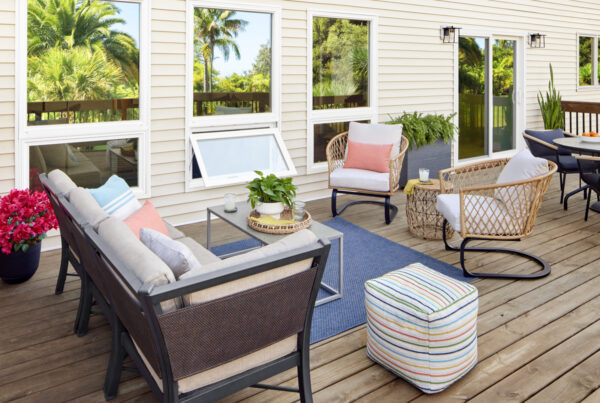When it comes to picking out new windows for your home, the sheer number of options can be a bit overwhelming—but you can count on two of the most popular choices to guide you through the noise and stand the test of time: casement windows and double-hung windows.
Both types of windows have their own personality that sets them apart from each other, so let’s dive into the differences and explain what makes them so unique. You’ll be enjoying the window view in time!
What Are Casement Windows?

You may not know them by name, but you’ve probably seen them around. Casement windows are hinged on the side and can be swung out, kind of like a door. They usually come with a crank, which makes them super easy to open and close, not to mention convenient for hard-to-reach spots around the inside of your home.
But these windows do more than just come in handy—so let’s take a closer look at all the benefits that casement windows bring to the table.
The Ins and Outs of Casement Windows
One of the biggest selling points of casement windows is the airflow they bring right to your home. Ventilation is everything in places around the house where you’re in dire need of a nice, fresh breeze, like the kitchen when you’re cooking or the living room when you’re kicking back.
On top of that, casement windows let you make the most out of your surroundings, thanks to their wide open views. By design, they’re a top-tier choice for rooms with a beautiful scene nearby.
And when they’re shut all the way, casement windows form a tight seal that acts as the first line of defense in more ways than one. It helps stop air from leaking out, which can lead to lower costs for heating and cooling your home and a more energy-efficient setup overall. Plus, the hook-shaped locks on the frame are extra secure because of the way they weave themselves into the window, making them even harder to break open.
But now that we’ve covered the sunny side of casement windows, let’s take in the whole picture. Casement windows are usually somewhat small, and larger casement windows are harder to install because they need more structural support.
On top of that, you’ll need room to clear the space that’s immediately outside your casement window because of how the sash opens. This could be trouble around tight spots—for example, if people walk along the sides of your house, or if there’s a shed, tree, fence, or any other physical object that stands just outside where you want your next window to be.
And in terms of maintenance and replacement, you’ll want to make sure that the crank and hinges on your casement window are kept up over time, since those are key to the window working properly.
What Are Double Hung Windows?
 Double-hung windows are one of the most popular styles of windows for a reason. These windows have two sashes (smaller frames holding glass panels) that slide up or down within the larger structure of the window frame.
Double-hung windows are one of the most popular styles of windows for a reason. These windows have two sashes (smaller frames holding glass panels) that slide up or down within the larger structure of the window frame.
You can open up both the upper and lower sashes, giving you multiple options for how you want to aerate your home, and so much more. Let’s get into the nitty gritty of what sets double-hung windows apart from casement windows.
What You Need to Know About Double-Hung Windows
When it comes to double-hung windows, you can open the top sash, bottom sash, or all of the above. This lets you get creative by switching up how you want to go about ventilating the room and circulating the air to your heart’s desire.
Most double-hung windows come with tilt-in sashes, meaning that you can tilt the two window panes inward, toward your home, so that you can easily clean the outside glass from inside your home.
Because double-hung windows open straight up and down, they don’t jut out into the surrounding inside or outdoor spaces—giving them the slight edge in places where your space is limited.
And as a nice contrast from the slick modern design of casement windows, double-hung windows have a timeless look that compliments a slew of different home styles.
But to be fair, double-hung windows are more prone to air leakage compared to casement windows, which can have an impact on how much energy your home saves in the long run.
And even when you open them up all the way, double-hung windows might not let in as much air as casement windows because, even when both of the sashes on a double-hung window are open, there’s still a slight blocking of the air where the two sashes meet in the middle.
Lastly, like casement windows, there’s somewhat of a need for maintenance over time, in the case of the tracks that move the sashes up and down can get worn down over time.
Casement vs. Double Hung Windows: Which Window Type is Best for Your Home?
Now that each style of window has had their chance to shine, let’s do some comparing and contrasting. At the end of the day, choosing between casement and double-hung windows comes down to personal preference and the style and build of your home. Casement windows are modern to the max, while double-hung windows are classic and timeless.
If you’re all about soaking in the view, then casement windows are the clear winner; they bring the beautiful scenery outside of your window right into your home. But if you’re not working with a lot of space around the outside of your house, then the straight-up-and-down nature of double-hung windows is the real victor.
When it comes to airflow, casement windows give you more of it since you can open the sash completely and let the breeze in from multiple angles. But double-hung windows give you more control of the airflow: you can open the top sash, bottom sash, or both to get the right balance.
For some people, the crank on casement windows can be easier to open compared to lifting and lowering the sashes on double-hung windows. But on the other hand, double-hung windows are straightforward, and as an added bonus, the tilt-in sashes make the glass easy to clean.
In terms of saving energy (heating and cooling costs), both casement and double-hung windows are safe bets. Still, casement windows have the slight edge over double-hung styles, thanks to their tight seal, which can make all the difference in places like Nebraska where the summers are sweltering and the winter winds are blustery.
Finally, in terms of cost, double-hung windows can be slightly more expensive than casement windows, but it can vary depending on the material of the window frame. For example, a single-wide double-hung window costs $903.16, compared to a single-wide casement window at $722.77. But fiberglass double-hung windows, at $942.07, are fairly similar to the cost of fiberglass casement windows at $935.80 for a single-wide option.
Find the Best Casement and Double-Hung Windows with Pella Windows & Doors of Omaha and Lincoln
Now that we’ve covered the differences between casement and double-hung windows, the only thing left for you to do is to weigh the pros and cons of each and make the decision that’s right for you and your home.
Whether you prefer casement windows for their larger-than-life views and ventilation or double-hung windows for a tighter fit and easy cleaning, we’re here to help you find the window that can take your home’s design to the next level.
At Pella Windows & Doors of Omaha and Lincoln, not only do we offer top-of-the-line windows and doors for any occasion, but we also offer some of the best warranties in the industry. Thanks to our Pella Care Guarantee, we make sure that your new windows are covered for years to come.
Schedule a free consultation today and learn more about how we can help you make the most out of your new installation with our premium selection of casement and double-hung windows.





